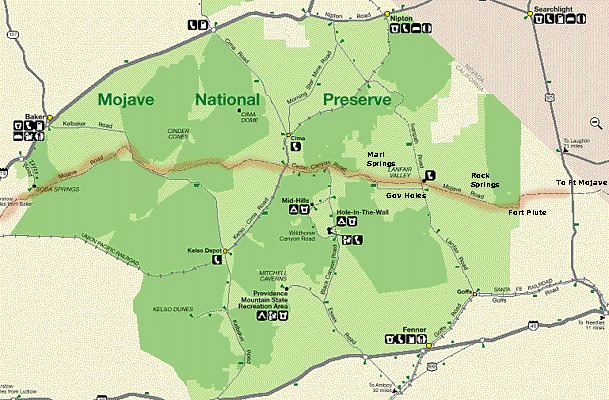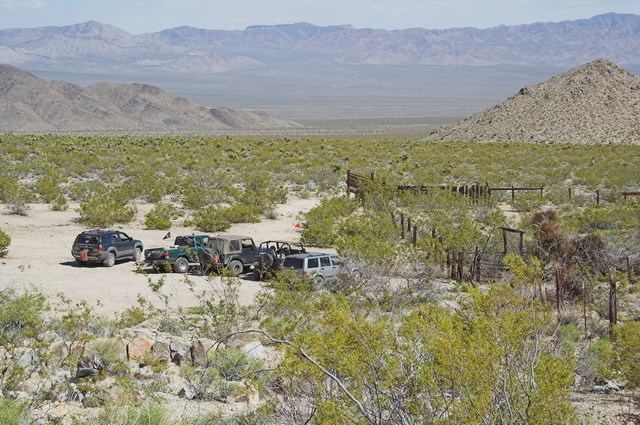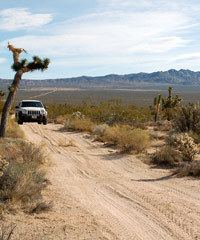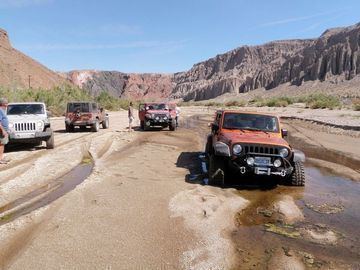 | ||
Mojave road october 2016 day 1 3
The Mojave Road, also known as Old Government Road formerly the Mohave Trail is a historic route and present day dirt road across what is now the Mojave National Preserve in the Mojave Desert in the United States. This rough road stretched 147 miles (237 km) from Beale's Crossing (the river crossing site on the west bank of the Colorado River, opposite old Fort Mohave, roughly 10 miles (16 km) southwest of Bullhead City, Arizona), to Fork of the Road location along the north bank of the Mojave River where the old Mojave Road split off from the route of the Old Spanish Trail/Mormon Road.
Contents
- Mojave road october 2016 day 1 3
- Mohave Trail
- Old Spanish Trail
- Mojave Road
- The route today
- Landmarks
- References

A four-wheel drive vehicle is required for all but a few short stretches of this road, which is unmaintained. The old road from Fork of the Road eastward along the Mojave River is interrupted after 10.9 acres (4.4 ha) by private property, below the site of the old Camp Cady (on the north bank of the Mojave River, roughly 12 miles (19 km) northeast of Newberry Springs, California). The road is resumed at an access point from the north in Manix Wash. Under optimal conditions, its full length of 133 miles (214 km) from Beale's Crossing to Manix Wash can be travelled in 2 to 3 days.
Mohave Trail

A traditional thoroughfare of desert-dwelling Native Americans, the Mohave Trail much later served Spanish missionaries, explorers, and foreign colonizers and settlers from the 18th to 19th centuries who called it the Mojave Trail, and ran between watering holes across the Mojave Desert between the Colorado River and Mojave River then following it to the Cajon Pass, the gap between the San Bernardino Mountains and San Gabriel Mountains, into Southern California. The watering holes recur at intervals of about 60 miles (97 km) to 70 miles (110 km).

Francisco Garcés, the Spanish Franciscan missionary, traveled the trail with Mohave guides, after leaving the expedition of Juan Bautista de Anza in 1776. José María de Zalvidea, the zealous Franciscan administrator of Mission San Gabriel also crossed the trail in 1806, reportedly converting five indigenous Mohaves near present-day Hesperia. In 1826, Jedediah Smith became the first North American to travel the Mojave Trail.
Old Spanish Trail
From 1829-30, Mexican traders from New Mexico established the routes that came to be called the Old Spanish Trail trade route to California. The first of these Armijo's route intercepted the Mohave's trail at the mouth of the Mojave River near Soda Lake.
Subsequenty in 1830, the Mohave's trail became part of what became the Main Route or Central Route of the Old Spanish Trail, linking up with it from the north 12 miles (19 km) west of the Colorado River in Piute Valley and following it westward to the link up with Armijo's route at the Mojave River mouth, and later with a short cut from Salt Spring through Bitter Spring and Spanish Canyon at a point just east of Yermo. This place was later called "Fork of the Road" where the Old Spanish Trail or from 1849, the Southern Route of the California Trail or the Mormon Road to Salt Lake City, divided from what came to be the Mojave Road to the Colorado River.
Now consolidated the Old Spanish Trail then followed the Mohave's trail along the Mojave River but instead of crossing over the mountains into San Bernardino Valley they followed a new route Armijo called "Cañon de San Bernardino" from the upper Mojave River west through Cajon Pass and down Crowder Canyon and Cajon Canyon, known to the vaqueros of the San Bernardino de Sena Estancia who had come to their aid with food.
Mojave Road
The land passed into American hands in 1848 and in early 1858 the Mohave Trail became the Mojave Road, a wagon road connected to the newly pioneered Beale's Wagon Road across northern New Mexico Territory from Fort Defiance to Beale's Crossing on the Colorado River where it linked up with the Mojave Road. Wagon trains of settlers coming west on the Santa Fe Trail, soon followed Beale's Wagon Road and the Mojave Road into Southern California. Beale's road was shorter than the route via the more southern Southern Emigrant Trail and it was cooler in summer and snow free in winter, had better forage and was better watered. Soon hostiities began between the Mohave's and the settlers, triggering the Mohave War.
From the time of the Mohave War the trail came under the purview of the U.S. government. Army posts were established at Fort Mojave, at Beale's Crossing in 1859 and after the Bitter Spring Expedition at Camp Cady, 10.9 miles (17.5 km) east of Fork of the Road, in 1860. Later in the 1860s, smaller outposts were established east of Camp Cady along the trail and regular patrols instituted. The army protected the settlers and travelers from the attacks of the resident Paiute, Mojave and Chemehuevi Native Americans until 1871. This also opened the way for large mining development in the Mojave Desert region of San Bernardino County and agricultural development in the Victor Valley area.
The route today
The eastern end of the Mojave Road begins at the edge of the Colorado River, near the site of Beale's Crossing, north of Needles and the western terminus lies beyond the Rasor Off-Highway Vehicle Area and the Afton Canyon Natural Area near the Manix Wash.
Landmarks
The following list of markers follows east to west travel.
